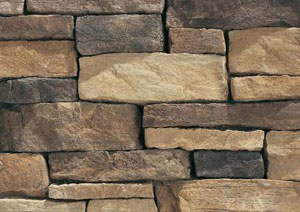Architectural Stone Veneers: Authentic and Appropriate Technology
Grout color hue and the finished joint technique significantly enhance the appearance and authenticity of stonewalls. Choosing a grout that is the same color as the stonewall is usually done in more traditional designs. This type of application will create the visual appearance of a solid plane. By changing the color of the grout, the designer highlights the individual stones. There are three major types of grout techniques, all of which are common to a typical brick mason.
-
Dry stack joints
Photo courtesy of Eldorado Stone
Example of a dry stack joint.
- Standard joints
- Overgrout joints
A dry stack joint is the placement of each veneer piece on top of the scratch coat with virtually no joint. Specifying a colored setting bed mortar to match the stone veneer color hue will blend any exposed areas and make them disappear. Standard grout joints are achieved by laying each stone roughly one-finger width apart. When laying a chimney with a stone veneer, the interlocking pieces can create interesting patterns as some stones may be laid vertically as well as horizontally. The semi-dry mortar is later “raked” to achieve a consistent depth between the stones. A raked mortar joint creates a shadow profile along each stone and highlights the character of these unique pieces. Commonly used to create a sense of rustic or “old world” surfaces, an overgrout joint overlaps the face of the veneer, widening the joints and making them very irregular by design.
Transition Details
All transition details should be carefully considered or supervised as the solutions to these fine details present the opportunities to create depth, dimension and authenticity in interior and exterior walls. Transition areas include corners, grade, windows, doors, chimneys and often in commercial properties, signs.
Corners
In order to emulate a solid wall installation, stone should appear to interlock. The installer should avoid a straight grout joint creating vertical line along a wall. For an interior corner, alternate the stone returning to the wall from wall to wall. An experienced installer will be able to execute an interior or exterior corner to create an authentic appearance of a stonewall. Some designers may choose to vary the colors of the stone at the corners to create the appearance of corner quoins, a traditional detail highlighting stone at corners or at the foundation area of a building.
At Grade
Building code officials should approve any installations where stone will be installed to grade. Most building codes require specific moisture barriers and/or insulation to be applied as part of a wall system at grade. There are also requirements for how close to grade a veneer product can be placed. A typical installation will require the veneer to be terminated a minimum of 4 in. above the earth surface and 2 in. above any paved surface. In general, corrosion-resistant flashing must be installed around all penetrations and terminations of veneer application. Flashing should be applied in accordance to local building requirements.
Arts and Crafts Designs at Montage Resort
During the heyday of the arts and crafts movement in America, a young English emigrant—an architect and painter—discovered the town of Laguna Beach. His sketches and paintings drew numerous artists and architects to settle in this picturesque seaside village. Drawing from the historic arts and crafts character of the site, the developers of the Montage Resort, in Laguna Beach, chose to replicate this arts and crafts style in the design of the resort. The buildings are constructed of wood and manufactured stone veneer, highly detailed to convey the rich traditions of this 19th century English style architecture. Careful attention to detail included the use of decorative stone surrounds at walls, chimneys, doors and windows. Each of these elements adds to the overall design authenticity of the resort.
| |||||||
Signs
The weight of the sign as well as the engineering of any attachments to stone veneer must be carefully considered. Some general guidelines for adhering signs with adhesives may be an option for a lightweight sign. After the wall is constructed and the stone veneer attached to the substrate in the appropriate fashion, signs, letters, small surfaces or logos can be adhered to the veneer as long as the combined weight of the sign and veneer does not exceed 15 p.s.f. In areas with recorded higher wind speeds, there may be additional requirements to document adhesive strength and compatibility with the wall system.
Larger signs can be attached to the framing by engineering an anchoring system. It is important to assure that there is a self-sealing waterproof membrane, a minimum of 12 in. square at each penetration, to avoid moisture problems. All signs should meet the building, planning and zoning codes.









